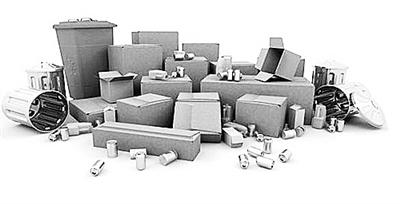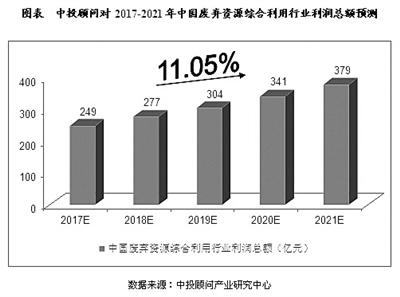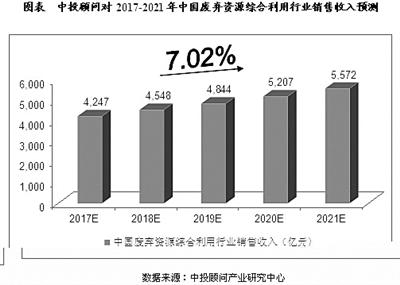Chinese waste import 50 million tons of imported waste | | | pollution _ news


> Investment advisor for 2017-2021 waste resources comprehensive utilization of total industry profit forecast

> Investment Advisor industry sales forecast for 2017-2021 waste resources comprehensive utilization of data sources: investment advisor industry research center
The Ministry of environmental protection, China's Ministry of Commerce, the national development and Reform Commission, the General Administration of customs, State administration of quality supervision has recently issued a circular, 7 species of solid waste from the limited list of imported solid wastes as raw materials into the catalog of banned the import of solid waste. New to "ban" respectively, cane molasses, MICA scrap, polycrystalline silicon scrap, the unvulcanized scrap, leather scrap, silicon and other waste and scrap of other molasses.
Solid wastes imported sounds far away from us, but it is close.
To a double in Shenzhen production of Nike shoes for cases: shoes was loaded in tray in the shipped to has American, American customer buy shoes Hou, put shoes box threw into has can recycling garbage barrels; then, shoes box was sent Shang has South California port of container ship, is may and from there was shipped back China; then again into paper mill, after cycle recycling into has new shoes box, again was sold to Nike such of business shoes enterprise, shoes box again was customer buy go......
China is the world's largest importer of scrap, but driven by high profits, cases of illegal import of solid waste is a high trend. Manage the importation of waste, pollution risk is placed in environmental protection, customs, quality inspection departments in front of common problems.
Importing "foreign garbage" profitable
Imported solid waste were not the general sense of "foreign garbage", but can be used as a raw material, solid waste that can be recycled. With China's rapid industrial development, the high demand for resources in various sectors of means of production, importation of solid waste has become a lucrative "big business".
According to statistics, China's annual imports of more than 50 million tons the waste used as raw material. But the import of solid waste is a handle "double-edged sword" and abroad solid wastes as raw materials make up the important sources of domestic demand, on the import trade in solid waste, to avoid illegal imports, processing and disposal of solid waste, especially hazardous waste cases have occurred, bring great harm to the environment.
"Imports of scrap to make up for the shortage of domestic resources, indirect reduction of pollutant emissions and energy consumption. "Water environment management division of the Department of environmental protection Deputy Director Li Lei said.
In 2012, for example, waste paper imported more than 28 million tons, compared with wood pulp and waste paper pulp to reduce chemical oxygen demand COD
About 240,000 tons, total industry-wide COD emissions more than 742,000 tons of 30%; imports of iron and steel scrap, copper scrap, aluminium scrap and other metal is about more than 14 million metric tons, reduce the emission of more than 900 million tons of solid waste, saving more than 13 million tons of standard coal, reducing sulfur dioxide emissions by 84,000 tons, 11,000 tons of nitrogen oxide emissions.
Recycled metals in the Beijing Ma Hongchang, a researcher at the Institute said imports "renewable resource" utilization is determined by the status of resources in China.
According to statistics, China's major mineral reserves per capita value less than 1/4 of the world. Copper and aluminium reserves per capita global per capita levels of 1/6 and 1/9, respectively, and copper resource self-sufficiency rate of less than 20%. China from 2002 to 2014, the cumulative imports 73.87 million tons of scrap electrical waste, 11% of total solid waste imports. Total dismantling of resources equivalent to 144 million tons of iron ore mining, saving a 76.5 million tons of copper concentrates, down 29.8 million tons of bauxite mining, saving 13.4 million tons of crude oil.
No such thing as a "lunch"
"We also have to clearly recognize, compared with primary resources, solid waste characteristics of complex, high levels of pollutants and resources characteristics of low quality. Based on the primary resource production process to avoid environmental pollution, and due to market fluctuations from time to time at a loss, not to mention solid waste as an alternative resource for the production process. "School of Tsinghua University, Professor Liu believes that solid waste has negative value" commodity ", regardless of the control measures, are required to pay a certain amount of economic costs. Control measures of higher environmental standards, fewer pollutants released into the environment, required to pay the economic costs of the higher, and vice versa.
Recovery and recycling system, China has imported a large amount of paper, plastic, metal and other wastes. Liu said that if further study of recycling where levels of environmental management and recycling facilities, may find that the situation is not optimistic, some waste was actually a contaminated environment and harm to human health at the expense of gets recycled. World famous, flourished in Guiyu, Guangdong electronic waste dismantling and recycling industry, a group of people from which to reap huge profits, but at the cost of environment will take a few generations to assume and repay.
Liu also said that solid waste disposal area is known as "dry bled" and achieve "zero pollution" "zero discharge" of "resource" technology, in fact, are either high cost, not market, enterprise is unsustainable, or "distorted" and "cheat" shift pollution problems.
Vein industry also known as the resource recycling industry, is the precondition to ensure environmental safety, for the purpose of saving resources and protecting the environment, the use of advanced technology, production and consumption in the process of converting waste into reusable resources and products. It is predicted that the 2016-2022, the output value of venous industrial park in China annual growth between 7%-9%, production 192.974 billion growth from 2015 to 2020 's 288.785 billion yuan.
Deputy Chief Engineer of the China Research Academy of environmental sciences said Qiao Qi researcher, venous industries rely on advanced technology, emphasis on efficient and clean of waste recycling, pollution is minimized. Vein industry development level is not high, but China development mode is single, waste recycling disposal and backward technology, low utilization of resource recycling technology development a serious shortage of investment, low transformation rate of scientific research achievements; enterprises engaged in scattered, small, which also led to the development of all the difficulties, difficult issues such as pollution control.
Solid waste "recycling" the first environment-friendly
Resources refers to "fully and rationally utilizing solid wastes" harmless "harmless disposal of solid waste."
"Solid waste ' resources ' is not unconditional, on condition that you must first meet the ' harmless ' requirements, achieve balance between environmental, social, and economic benefits. "Liu said," harmless of "is solid waste management of fundamental purpose, from solid waste of produced, and collection, and transport to regeneration using, are must followed this a requirements, cannot meet" harmless of "requirements of" resources of ", just pollution transfer or diffusion, not only on improved environment quality no active role, instead will on human health and ecological environment produced more big against.
In fact, the Ministry of environmental protection, China's Ministry of Commerce, China's national development and Reform Commission and other five ministries and strict system of classified management of imported waste raw materials, cannot be used as a raw material or not the harmless use of solid wastes included in the list of banned imports, to include solid waste can be used as a renewable raw material imports, automatic licensing import directory. And according to the harmless use of make up for the shortage of resources, technology, pollution intensity on three directories to dynamically adjust.
Department of environmental protection also said that from January 9 this year banned the import of solid waste such as sugar cane molasses adjustments, based on prevention and control of environmental pollution by solid waste law, the importation of solid waste management measures, combined with the implementation of the list of imported solid waste management. The primary objective is to further regulate the importation of solid waste management, control of imported solid waste pollution.
However, the high cost of solid waste management in developed countries and smuggled into countries ban the import of waste, waste treatment fees may be charged abroad and domestic pollution of the environment use, making "double" profits. "Combating smuggling of solid waste is a long-term and arduous task. "Li Lei said.
Technology pain points of solid waste utilization. China national resources recycling Association, said Liu Qiang, Vice, resource recycling industry is a typical policy-driven industries, should further improve laws and regulations, strengthen government support and guidance role across related industry personnel training system should be established, such as setting up key laboratories, research centers and other research institutions.
Source: Science Daily
> Editor: Zhang di
Article keywords:Imports of waste
I want feedback
Save a Web page
Xinhua
中国每年进口废料五千万吨|进口|废料|污染_新闻资讯


>中投顾问对2017—2021年中国废弃资源综合利用行业利润总额预测

>中投顾问对2017—2021年中国废弃资源综合利用行业销售收入预测 数据来源:中投顾问产业研究中心
环境保护部、中国商务部、国家发展改革委、海关总署、国家质检总局日前联合发出通知,将7种固体废物从《限制进口类可用作原料的固体废物目录》调入《禁止进口固体废物目录》。新进入“禁令”的分别是甘蔗糖蜜、云母废料、多晶硅废碎料、未硫化橡胶废碎料、皮革制品边角料、其他糖蜜、其他硅废碎料。
固体废物进口听起来离我们每个人很远,其实却很近。
以一双在深圳生产的耐克鞋为例:鞋子被装在纸盒中运到了美国,美国顾客买鞋后,把鞋盒扔进了可回收垃圾桶;随后,鞋盒被送上了南加利福尼亚港口的集装箱船,很可能又从那里被运回中国;然后再进入造纸厂,经过循环再造变成了新鞋盒,再次被出售给耐克这样的制鞋企业,鞋盒再次被顾客买走……
中国是全球最大的废料进口国,但在高额利润驱使下,非法进口固体废物案件也呈高发态势。管理好废料进口,解决污染隐患是摆在环保、海关、质检等部门面前的共同难题。
进口“洋垃圾”有利可图
进口固体废物并非一般意义上的“洋垃圾”,而是能够用作原料,可被循环利用的固体废物。随着中国工业的快速发展,各行业对资源性生产资料的需求高涨,固体废物进口已成为有利可图的“大生意”。
据统计,中国每年进口用作原料的废料约5000多万吨。但固体废物进口是一柄“双刃剑”,国外可用作原料的固体废物成为弥补国内需求的重要来源;另一方面,在固体废物进口贸易中,逃避监管非法进口、加工、处置固体废物特别是危险废物情况屡有发生,给环境带来巨大危害。
“进口废料弥补了国内资源不足,间接减少污染排放和能源消耗。”环境保护部水环境管理司副司长李蕾说。
以2012年的数据为例,进口废纸2800多万吨,与原木制浆比较,废纸制浆减少化学需氧量COD
排放约24万吨,占全行业COD总排放量74.2万吨的三成以上;进口废钢铁、废铜、废铝等金属共约1400多万吨,减少固体废物排放9亿多吨,节能1300多万吨标准煤,减少二氧化硫排放8.4万吨、氮氧化物排放1.1万吨。
北京中色再生金属研究所研究员马鸿昌说,进口“再生资源”进行综合利用,是中国资源匮乏现状所决定的。
据统计,中国主要金属矿产人均储量值不足全球的1/4。其中,铜和铝的人均储量分别为全球人均水平的1/6和1/9,铜资源自给率不足20%。中国从2002年到2014年,累计进口废五金电器类废物7387万吨,占固体废物进口量的11%。累计拆解得到的资源,相当于减少1.44亿吨铁矿石的开采,节约了7650万吨铜精矿,减少了2980万吨铝土矿的开采,节约了1340万吨原油等。
没有白吃的“午餐”
“我们也必须要清醒地认识到,与原生资源相比,固体废物具有特性复杂多变,污染物含量高,资源品质低的特点。以原生资源为基础的生产过程尚且难以避免环境污染,而且由于市场波动不时处于亏损状态,更不用说将固体废物作为替代资源的生产过程。”清华大学环境学院教授刘建国认为,固体废物是具有负价值的“商品”,无论采用何种控制措施,都需支付一定的经济成本。控制措施的环保标准越高,向环境排放污染物越少,需支付的经济成本就越高,反之亦然。
中国废品回收系统回收并进口了大量的纸张、塑料、金属类等废物。刘建国说,如果进一步考察回收废品的去向、回收利用设施的环境管理水平,可能会发现形势并不乐观,部分废品实际上是以污染环境、危害人体健康为代价得到回收利用的。如全球闻名、盛极一时的广东贵屿电子废物拆解与回收产业,一批人从中攫取了巨额利润,但付出的环境代价要数代人来承担和偿还。
刘建国还表示,固体废物处理领域一些号称能够“吃干榨尽”、实现“零污染”“零排放”的“资源化”技术,实际上都存在要么处理成本高、产品无市场,企业难以为继,要么“移花接木”“瞒天过海”转移污染等问题。
静脉产业又称资源再生利用产业,是以保障环境安全为前提,节约资源、保护环境为目的,运用先进技术,将生产和消费过程中产生的废物转化为可重新利用的资源和产品等。据预测,2016—2022年,中国静脉产业园产值年增速在7%—9%之间,产值将从2015年的1929.74亿元增长到2020年的2887.85亿元。
中国环境科学研究院副总工乔琦研究员说,静脉产业发展依靠先进技术,强调对废物的高效和清洁回收、污染排放最小化。但中国静脉产业发展技术水平不高、发展模式单一,废旧资源回收处理处置工艺落后,资源循环利用率偏低;技术开发投入严重不足,科研成果转化率低;企业普遍经营分散、规模小,这也导致了产业发展困难重重,污染控制难度大等问题。
固废“资源化”首先要无害于环境
资源化是指“充分合理利用固体废物”, 无害化指“无害化处置固体废物”。
“固体废物的‘资源化’并不是无条件的,条件就是首先必须满足‘无害化’要求,取得环境效益、社会效益、经济效益之间的平衡。”刘建国说,“无害化”才是固体废物管理的根本目的,从固体废物的产生、收集、运输到再生利用等都必须遵循这一要求,无法满足“无害化”要求的“资源化”,不过是污染转移或扩散,不但对改善环境质量没有积极作用,反而会对人体健康和生态环境产生更大危害。
其实,环保部、中国商务部、中国国家发展改革委员会等五部委对进口废物原料实行严格的分类管理制度,即将不能用作原料或者不能以无害化方式利用的固体废物列入禁止进口目录,将可以用作再生原料的固体废物列入限制进口、自动许可进口目录。并根据弥补资源短缺、无害化方式利用技术、污染排放强度等因素对三个目录进行动态调整。
环保部也表示,从今年1月9日开始禁止进口甘蔗糖蜜等固体废物的调整,就是根据固体废物污染环境防治法、《固体废物进口管理办法》,结合进口固体废物管理目录的执行情况做出的。该调整是为了进一步规范固体废物进口管理,防治进口固体废物环境污染。
不过,发达国家固体废物处理成本高,走私进口国家禁止进口的废物,既可收取国外垃圾处理费,又在国内以污染环境方式利用,牟取“双重”暴利。“打击固体废物走私是一项长期而艰巨的任务。”李蕾说。
技术也是固体废物利用的痛点。中国物资再生协会常务副会长刘强说,资源再生利用产业是典型的政策法规驱动型产业,应进一步完善国家相关法律、法规等,加强政府扶持和引导作用;各地应建立相关产业的人才培养体系,如在科研机构成立重点实验室、科研中心等。
来源:科技日报
>责任编辑:张迪
文章关键词: 进口 废料 污染
我要反馈
保存网页
新华网